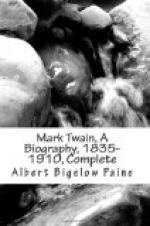There is nothing in any of his earlier notes or letters to indicate that he contemplated the story of Joan as early as the eighties; but there is a bibliographical list of various works on the subject, probably compiled for him not much later than 1880, for the latest published work of the list bears that date. He was then too busy with his inventions and publishing schemes to really undertake a work requiring such vast preparation; but without doubt he procured a number of books and renewed that old interest begun so long ago when a stray wind had blown a leaf from that tragic life into his own. Joan of Arc, by Janet Tuckey, was apparently the first book he read with the definite idea of study, for this little volume had been recently issued, and his copy, which still exists, is filled with his marginal notes. He did not speak of this volume in discussing the matter in after-years. He may have forgotten it. He dwelt mainly on the old records of the trial which had been dug out and put into modern French by Quicherat; the ‘Jeanne d’Arc’ of J. Michelet, and the splendid ‘Life of the Maid’ of Lord Ronald Gower, these being remembered as his chief sources of information.—[The book of Janet Tuckey, however, and ten others, including those mentioned, are credited as “authorities examined in verification” on a front page of his published book. In a letter written at the conclusion of “Joan” in 1895, the author states that in the first two-thirds of the story he used one French and one English authority, while in the last third he had constantly drawn from five French and five English sources.]
“I could not get the Quicherat and some of the other books in English,” he said, “and I had to dig them out of the French. I began the story five times.”
None of these discarded beginnings exists to-day, but we may believe they were wisely put aside, for no story of the Maid could begin more charmingly, more rarely, than the one supposedly told in his old age by Sieur Louis de Conte, secretary of Joan of Arc, and translated by Jean Francois Alden for the world to read. The impulse which had once prompted Mark Twain to offer The Prince and the Pauper anonymously now prevailed. He felt that the Prince had missed a certain appreciation by being connected with his signature, and he resolved that its companion piece (he so regarded Joan) should be accepted on its merits and without prejudice. Walking the floor one day at Viviani, smoking vigorously, he said to Mrs. Clemens and Susy:
“I shall never be accepted seriously over my own signature. People always want to laugh over what I write and are disappointed if they don’t find a joke in it. This is to be a serious book. It means more to me than anything I have ever undertaken. I shall write it anonymously.”
So it was that that gentle, quaint Sieur de Conte took up the pen, and the tale of Joan was begun in that beautiful spot which of all others seems now the proper environment for its lovely telling.




